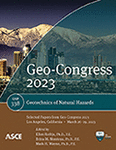Liquefaction Strength of Ottawa Sand: CDSS Experiments and ANN Modeling
Publication: Geo-Congress 2023
ABSTRACT
Characterization of the liquefaction strength of sandy soils is essential in modeling geotechnical engineering problems involving liquefiable soils. This paper investigates the liquefaction strength of Ottawa F65 sand through an extensive series of undrained, stress-controlled, cyclic direct simple shear (CDSS) tests performed at different densities, overburden pressures, and static shear stresses prior to cyclic shearing. The relatively large number of CDSS tests is used to develop an artificial neural network (ANN) model in order to predict Ottawa F65 liquefaction strength for densities and loading conditions that are not available in the experimental results. The predictive capability of the ANN model is assessed using blind predictions of the cyclic strength in new CDSS tests for a relative density and vertical effective stress not available in the training data set. Afterwards, CDSS tests under similar conditions were carried out. The comparisons of the predictions with the experimental results suggest that the ANN model provides reasonably good and conservative predictions of the soil liquefaction strength and shows sensitivity to changes in vertical effective stress, soil density, and cyclic stress ratio.
Get full access to this article
View all available purchase options and get full access to this chapter.
REFERENCES
Abbaszadeh Shahri, A. (2016). Assessment and prediction of liquefaction potential using different artificial neural network models: a case study. Geotechnical and Geological Engineering, 34(3), 807–815.
Alizadeh Mansouri, M., and Dabiri, R. (2021). Predicting the liquefaction potential of soil layers in Tabriz city via artificial neural network analysis. SN Applied Sciences, 3(7), 1–31.
Bastidas, A. M. P. (2016). Ottawa F-65 sand characterization. University of California, Davis.
Beale, M. H., Hagan, M. T., and Demuth, H. B. (2010). Neural network toolbox. User’s Guide, MathWorks, 2, 77–81.
Boulanger, R. W. (2003). Relating Kα to relative state parameter index. Journal of Geotechnical and Geoenvironmental Engineering, 129(8), 770–773.
Boulanger, R. W., and Idriss, I. M. (2004). Evaluating the potential for liquefaction or cyclic failure of silts and clays (p. 131). Davis, California: Center for Geotechnical Modeling.
Carey, T. J., Stone, N., and Kutter, B. L. (2020). Grain Size Analysis and Maximum and Minimum Dry Density Testing of Ottawa F-65 Sand for LEAP-UCD-2017. In: Kutter, B., Manzari, M., Zeghal, M. (eds) Model Tests and Numerical Simulations of Liquefaction and Lateral Spreading. Springer, Cham. https://doi.org/10.1007/978-3-030-22818-7_2.
Castro, G., and Poulos, S. J. (1977). Factors affecting liquefaction and cyclic mobility. Journal of the Geotechnical Engineering Division, 103(6), 501–516.
ElGhoraiby, M. A., Park, H., and Manzari, M. T. (2020). Stress-strain behavior and liquefaction strength characteristics of Ottawa F65 sand. Soil Dynamics and Earthquake Engineering, 138, 106292.
Erzin, Y., and Ecemis, N. (2015). The use of neural networks for CPT-based liquefaction screening. Bulletin of Engineering Geology and the Environment, 74(1), 103–116.
Goh, A. T. (1994). Seismic liquefaction potential assessed by neural networks. Journal of Geotechnical Engineering, 120(9), 1467–1480.
Idriss, I. M., and Boulanger, R. W. (2008). Soil Liquefaction during Earthquake., Earthquake Engineering Research Institute, Oakland.
Juang, C. H., Yuan, H., Lee, D. H., and Lin, P. S. (2003). Simplified cone penetration test-based method for evaluating liquefaction resistance of soils. Journal of Geotechnical and Geoenvironmental Engineering, 129(1), 66–80.
Kiran, S., Lal, B., and Tripathy, S. (2016). Shear strength prediction of soil based on probabilistic neural network. Indian J. Sci. Technol, 9(41), 1–6.
Manzari, M., Ghoraiby, M. E., Kutter, B. L., and Ziotopoulou, K. (2017). Liquefaction analysis and experiment projects (LEAP): Summary of observations from the planning phase. International Journal of Soil Dynamics and Earthquake Engineering, https://doi.org/10.1016/j.soildyn.2017.05.015.
Manzari, M. T., et al. (2020). LEAP-2017 Simulation Exercise: Calibration of Constitutive Models and Simulation of the Element Tests. In: Kutter, B., Manzari, M., Zeghal, M. (eds) Model Tests and Numerical Simulations of Liquefaction and Lateral Spreading. Springer, Cham. https://doi.org/10.1007/978-3-030-22818-7_9.
Nasir, V., and Sassani, F. (2021). A review on deep learning in machining and tool monitoring: methods, opportunities, and challenges. The International Journal of Advanced Manufacturing Technology, 115(9), 2683–2709.
Richard, J. A., Sa’don, N. M., and Karim, A. R. A. (2021). Artificial neural network (ANN) model for shear strength of soil prediction. In Defect and Diffusion Forum (Vol. 411, pp. 157–168). Trans Tech Publications Ltd.
Seed, H. B., and Lee, K. L. (1966). Liquefaction of saturated sands during cyclic loading. Journal of the Soil Mechanics and Foundations Division, 92(6), 105–134.
Seed, H. B., and Idriss, I. M. (1982). Ground Motions and Soil Liquefaction during Earthquakes. Earthquake Engineering Research Institute Monograph, Oakland.
Vargas, R. R., Ueda, K., and Uemura, K. (2020). Influence of the relative density and K0 effects in the cyclic response of Ottawa F-65 sand-cyclic Torsional Hollow-Cylinder shear tests for LEAP-ASIA-2019. Soil Dynamics and Earthquake Engineering, 133, 106111.
Vasko, A. (2015). An investigation into the behavior of Ottawa sand through monotonic and cyclic shear tests. The George Washington University.
Young-Su, K., and Byung-Tak, K. (2006). Use of artificial neural networks in the prediction of liquefaction resistance of sands. Journal of Geotechnical and Geoenvironmental Engineering, 132(11), 1502–1504.
Information & Authors
Information
Published In
History
Published online: Mar 23, 2023
ASCE Technical Topics:
- Artificial intelligence and machine learning
- Computer programming
- Computing in civil engineering
- Effective stress
- Engineering fundamentals
- Engineering mechanics
- Geomechanics
- Geotechnical engineering
- Laboratory tests
- Neural networks
- Shear stress
- Shear tests
- Soil liquefaction
- Soil mechanics
- Soil properties
- Soil strength
- Soil stress
- Static loads
- Statics (mechanics)
- Stress (by type)
- Structural analysis
- Structural engineering
- Tests (by type)
- Vertical loads
Authors
Metrics & Citations
Metrics
Citations
Download citation
If you have the appropriate software installed, you can download article citation data to the citation manager of your choice. Simply select your manager software from the list below and click Download.
